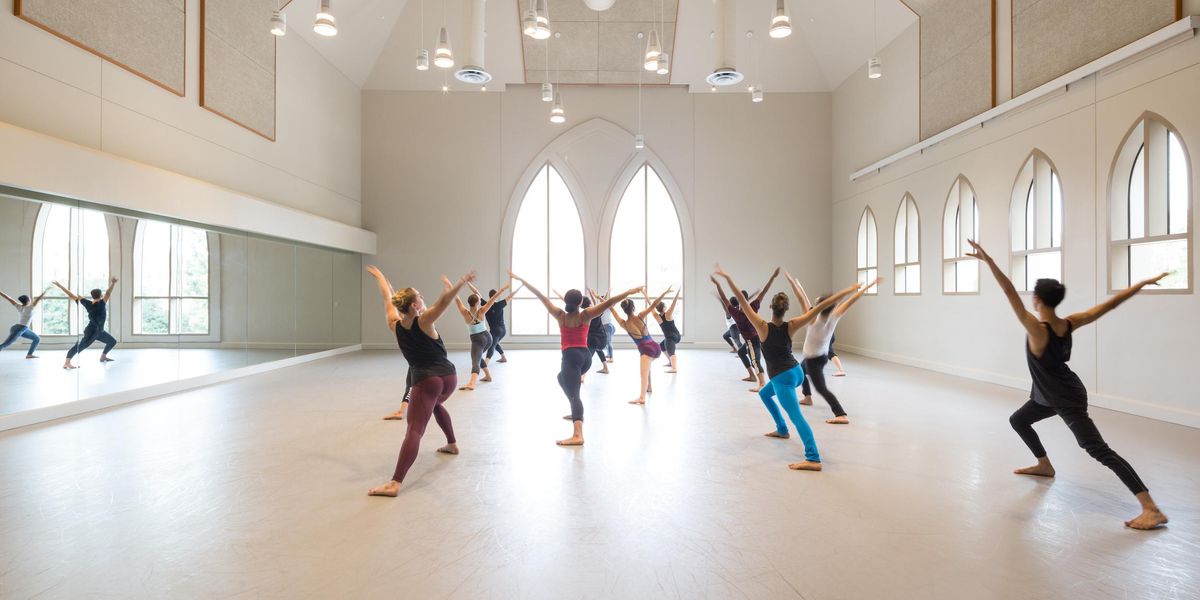Even More Electric
Photos by Jim Lafferty
As Victor Quijada celebrates 15 years of RUBBERBANDance Group, his company turns a new corner.
The dancers of RUBBERBANDance Group are only marking their movements before a run-through, but you can sense their explosive potential. Their bodies channel dynamic, liquid grace one moment, then hit a sharp elbow punch the next. Similarly, artistic director Victor Quijada is giving notes in a calm, even tone, advising one dancer “You should go closer to the floor before you get lifted,” but the impression is of tightly compressed energy. Between them, the dancers and the choreographer seem like they have enough electricity to power the theater without any external circuits.
Over the course of its 15-year history,
RUBBERBAND has been incorporating street styles as well as contemporary and classical traditions, bringing them together in a powerful union. Quijada sees himself as an ambassador between genres. “I want to do what I can to push these forms to meet somewhere in the middle, or by knowing each other, rebound and go somewhere different,” he says.
During a preshow rehearsal in Philadelphia, the dancers’ controlled energy helps them soar through lifts and flips. Here, Paco Ziel and Lavinia Vago.
Raised in Los Angeles by Mexican immigrant parents, Quijada was first immersed in hip-hop culture through clubs and other social settings, and later introduced to contemporary dance at the Los Angeles County High School for the Arts by postmodern pioneer Rudy Perez. After stints dancing with Twyla Tharp and Les Grands Ballets Canadiens de Montréal, Quijada founded his own company in 2002, choosing Montreal as a home base. “Montreal seems to be just the right place for RUBBERBAND to thrive,” he says. He cites the high priority placed on culture, as well as the relatively low cost of living, but also notes the receptivity of its citizens. “There’s a lot of open minds, and there’s an audience for all types of disciplines,” he says. “The street-dance scene is very strong.”
Quijada’s movement mixes break dancing’s virtuosity with contemporary dance’s nuance.
The RUBBERBAND dancers are intrepid. Quijada explains, “I’m looking for beasts. I’m looking for fearlessness. I’m looking for people who are not afraid to connect with whatever makes them tick, and channel that through their practice.” They need to be fearless in part because they are so often upside down, or teasingly sideways, or unexpectedly inverting on a dime. “What we do is about finding freedom outside of the vertical plumb line of ballet and using that freedom to allow the body to more easily find its way into the horizontal and the inverted.”
This exploration is evident in RUBBERBAND’s current touring show,
Vic’s Mix, a mashup of excerpts from Quijada’s past work. Company apprentice Sydney McManus gobbles up space even in a series of deep backbends while Paco Ziel seems as comfortable reclining sideways in midair as someone else might while lounging on the couch. “Vic’s Mix is about celebrating the path of the company, this 15 year process that I’ve set out on,” says Quijada. “It’s about saying, Yeah, we can do this. The body can do this.”
Amara Barner (left) grew up on the convention circuit. Sovann Rochon-Prom Tep (right) started as a b-boy.
Earlier this season, Quijada lost his longtime muse and artistic co-director Anne Plamondon, who stepped down after 11 years to focus on her own choreography, becoming the company’s first artist in residence. One of their major accomplishments is the RUBBERBAND Method, which Quijada developed in close collaboration with Plamondon. The training system helps dancers without break or contemporary technique become fluent in both. “Just until recently, everything had to come through my body, and then the dancers would take that apart and bring it back together and improvise with it,” says Quijada. The method prepares dancers not only to tackle the demands of his choreography, but to interpret his work, and truly become part of the process, creating a “big explosion of work” together. He now teaches students the RUBBERBAND Method through an annual summer intensive in Montreal and at the Glorya Kaufman School of Dance at University of Southern California, where he is an artist in residence. He also gives workshops that offer a taste of the method when the company is on tour.
So what’s next? This year, the company will premiere a major new choose-your-own-adventure site-specific work, the details of which will be announced soon. But one thing is sure: In true RUBBERBANDance tradition, it will continue Quijada’s history of melding the classical with the urban.




